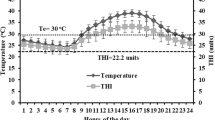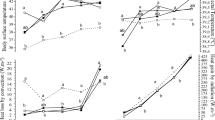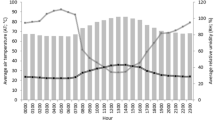Abstract
The goal of this study was to evaluate the daily rhythmicity of the thermoregulatory responses of Morada Nova ewes that were raised in a semiarid environment. The experiment was conducted during the dry season. Data were collected from 5:00 a.m. to 4:00 a.m.. Samples were taken over the course of 8 days, with a 1-week interval between sampling periods. During each day that the data were collected, animals were measured once an hour for 24 h in an area directly exposed to solar radiation. The environment was characterized by measuring the following variables: air temperature (TA), relative humidity (RH), Black Globe Humidity Index (BGHI), radiant heat load (RHL), and wind speed (WS). Physiological variables that were measured included rectal temperature (RT, °C), respiratory rate (RR, breaths/min), surface temperature (ST, °C), and sweating rate (SR, g m2 h−1). We observed that RT, RR, and ST increased as environmental conditions became more stressful. Specifically, environmental conditions became more stressful as RHL, air temperature, and BGHI increased, while RH decreased. All physiological variables of the animals were strongly affected by the time of the day: environmental variables changed drastically between nighttime and noon. Physiological parameters increased sharply from the morning (7:00 a.m.–10:00 a.m.) until noon (11:00 a.m.–2:00 p.m.), except for sweating rate. After noon, these variables began to drop until nighttime (11:00 p.m.–6:00 am), and values of the main physiological indexes were stable during this period. The Morada Nova breed exhibited daily cyclic variations in thermoregulatory responses. Evaporative heat loss mechanisms were triggered during the most stressful times of the day. The first mechanism that animals used was panting, which was an immediate response to environmental heat stress. Cutaneous evaporation had a slower response mechanism to environmental heat stress. Homeothermy conditions were restored to the animals at approximately 5:00 p.m.; however, these findings confirm the importance of providing environmental protection during critical periods of the day, even for locally adapted breeds. These responses suggest that the use of thermal storage allowed the animals to achieve equilibrium with the environment and maintain a stable body temperature.



Similar content being viewed by others
References
Alamer M, Al-Hozab A (2004) Effect of water deprivation and season on feed intake, body weight and thermoregulation in Awassi and Najdi sheep breeds in Saudi Arabia. J Arid Environ 59:71–84
Anderson MJ, Gorley RN, Clarke KR (2008) PERMANOVA+ for PRIMER: guide to software and statistical methods. PRIMER-E Ltd, Plymouth
Baêta FC, Souza CF (2010) Ambiência em edificações rurais: conforto animal, 2.ed edn. UFV, Viçosa 269
Baker MA (1989) Effects of dehydration and rehydration on thermoregulatory sweating in goats. J Physiol 417:421–435
Bernabucci U, Lacetera N, Baumgard LH, Rhoads RP, Ronchi B, Nardone A (2010) Metabolic and hormonal acclimation to heat stress in domesticated ruminants. Animal 4:1167–1183
Bligh J (1961) The synchronous discharge of apocrine sweat glands of the Welsh Mountain sheep. Nat Lond 189:582–583
Bligh J (1998) Mammalian homeothermy: an integrative thesis. J Therm Biol 23:143–258
Brown SA, Schibler U (1999) The ins and outs of circadian timekeeping. Curr Opin Genet Dev 9:588–594
Buffington DE, Collazo-Arocho A, Canton GH, Pitt D, Thatcher WW, Collier RJ (1981) Black globe-humidity index (BGHI) as comfort equation for dairy cows. Trans ASABE 24:711–714
Cezar MF, Souza BB, Souza WH, Pimenta Filho EC, Tavares GP, Medeiros GX (2004) Avaliação de parâmetros fisiológicos de ovinos Dorper, Santa Inês e seus mestiços perante condições climáticas do trópico semi-árido nordestino. Ciênc Agrotec 28:614–620
Collier RJ, Gebremdhin (2015) Thermal biology of domestic animals. Annu Rev Anim Biosci 3:513–532
Cordão MA, Souza BB, Pereira GM, Bakke OA, Silva AMA, Lopes JJ (2010) Respostas fisiológicas de cordeiros Santa Inês em confinamento à dieta e ao ambiente físico no trópico semiárido. Agropecuária Científica no Semi-Árido 6:47–51
Costa CCM, Maia ASC, Fontenele Neto JD, Oliveira SEO, Queiroz JPAF (2014) Latent heat loss and sweat gland histology of male goats in an equatorial semi-arid environment. Int J Biometeorol. doi:10.1007/s00484-013-0642 2
Delaunay F, Laudet V (2002) Circadian clock and microarrays: mammalian genome gets rhythm. Trends Genet 18:595–597
Dmi’el R, Robertsshaw D (1983) The control of panting and sweating in the black Bedouin goat: a comparison of two modes of imposing a heat load. Physiol Zool 56:404–411
Esmay ML (1969) Principles of animal environment, 2ed edn. AVI, Wastport 325
Façanha DAE, Maia ASC, Silva RG, Vasconcelos AM, Lima PO, Guilhermino MM (2008) Variação anual de hormônios tireoideanos e características termorreguladoras de vacas leiteiras em ambiente quente. R Bras Zootec 37:538–545
Façanha DAE, Silva RG, Maia ASC, Guilhermino MM, Vasconcelos AM (2010) Variação Anual de características morfológicas e da temperatura de superficie do pelame de vacas da raça Holandesa em ambiente semiárido. R Bras Zootec 39:837–844
Finch VA (1985) Comparison of non-evaporative heat transfer in different cattle breeds. Aust J Agric Res 36:497–508
Finch VA (1986) Body temperature in beef cattle: its control and relevance to production in the tropics. J Anim Sci 62:531–542
Gatenby Ruth M (1986) Exponential relation between sweat rate and skin temperature in hot climates. J Agric Sci 106:175–183
Gebremedhin KG, Cramer CO, Porter WP (1981) Predictions and measurements of heat production and food and water requirements of Holstein calves in different environments. Trans ASAE 3:715–720
Gebremedhin KG, Hillman PE, Lee CN, Collier RJ, Willard ST, Arthington JD, Brown-Brandl TM (2008) Sweating rates of dairy cows and beef heifers in hot conditions. Trans ASABE 51(6):2167–2178. doi:10.13031/2013.25397
Gomes CAV, Furtado DA, Medeiros NA, Silva DS, Pimenta Filho EC, Lima Júnior V (2008) Efeito do ambiente térmico e níveis de suplementação nos parâmetros fisiológicos de caprinos Moxotó. R Bras Eng Agríc Ambiental 12:213–219
Gonzaga Neto S, Silva Sobrinho AG, Resende KT, Zeola NMBL, Silva AMA, Marques CAT, Leão AG (2005) Body composition and nutritional requeriments of protein and energy for Morada Nova lambs. R Bras de Zootec 34:2446–2456 supl.
Hahn GL, Parkhurst AM, Gaughan JB (1997) Cattle respiration rate as a function of ambient temperature. ASAE Paper no. MC 97–121. ASAE St. Joseph, Mich
IDEMA 2003 Instituto de Defesa do Meio Ambiente
INEMET 2009 Instituto Nacional de Meteorologia
Jiang M, Gebremedhin KG, Albright LD (2005) Simulation of skin temperature and sensible and latent heat losses through fur layers. Tran ASAE 48(2):767–775. doi:10.13031/2013.18319
Kumar D, De K (2013) Extreme climatic variables affecting male reproduction in sheep. In: Sahoo A, Kumar D, SMK N (eds) Climate resilient small ruminant production. National Initiative on Climate Resilient Agriculture (NICRA). Central Sheep and Wool Research Institute, Izatnagar, pp 1–106
Leite JHGM (2011) Caracterização de atributos adaptativos de ovinos da raça Morada Nova. Mossoro:UFERSA. 93 p, Dissertação de Mestrado
Luz CSM, Fonseca WJL, Barros Junior CP, Terto E, Sousa GG, Amorim RB, Silva LA, Lima LA, Sousa Júnior SC, Santos KR (2014) Characteristics estimates of thermoregulatory sheep in rainy and dry seasons created in the region Gurguéia Valley, south of the state of Piaui. Acta Veterinaria Brasilica 8:19–24
Mader TL, Johnson LJ, Gaughan JB (2010) Components of the comprehensive climate index. J Anim Sci. doi:10.2527/jas.2009-2586
Maia ASC, Silva RG, Battiston CM (2005a) Respiratory heat loss of Holstein cows in a tropical environment. Int J Biometeorol 49:332–336. doi:10.1007/s00484-004-0244-0
Maia ASC, Silva RG, Battiston CM (2005b) Sensible and latent heat loss from body surface of Holstein cows in a tropical environment. Int J Biometeorol (in press) 50:17–22. doi:10.1007/s00484-005-0267-1
Marai IFM, El-Darawany AA, Fadiel A, Abdel-Hafez MAM (2007) Physiological traits as affected by heat stress in sheep—a review. Small Rumin Res 71:1–12
Marai IFM, El-Darawany AA, Abou-Fandoud EI, Abdel-Hafez MAM (2009) Reproductive and physiological traits of Egyptian Suffolk rams as affected by selenium dietary supplementation during the sub-tropical environment of Egypt. Livest Res Rural Dev 21:1–12
McLean JA (1963) The partition of insensible losses of body weight in heat from cattle under various climatic conditions. J Physiol 167:427–447
McManus C, Paludo GR, Louvandini H, Gugel R, Sasaki LCB, Paiva SR (2009) Heat tolerance in Brazilian sheep: physiological and blood parameters. Trop Anim Health Prod 41:95–101
McManus C, Louvandini H, Gugel R, Sasaki LCB, Bianchini E, Bernal FEM, Paiva SR, Paim TP (2011) Skin and coat traits in sheep in Brazil and their relation with heat tolerance. Trop Anim Health Prod 43:121–126. doi:10.1007/s11250-010-9663-6
Naqvi SMK, Sejian V (2010) Physiological adaptation of sheep to hot environmental conditions with special reference to climate change. In: Karim SA, Joshi A, Sankhyan SK, Shinde AK, Shakyawar DB, Naqvi SMK, Tripathi BN (eds) Climate change and stress management: sheep and goat production, 1st edn. Satish, Delhi, pp 259–282
Olsson K, Dahlborn K (1989) Fluid balance during heat stress in lactation goats. Q J Exp Physiol 74:645–659
Paim TP, Borges BA, Lima PMT, Gomes EF, Dallago BSL, Fadel R, Menezes AM, Louvandini H, Canozzi MEA, Barcellos JOJ, McManus C (2013) Thermographic evaluation of climatic conditions on lambs from different genetic groups. Int J Biometeorol 57:59–66
Pereira AMF, Alves A, Infante P, Titto EAL, Baccari F Jr, Almeida JAA (2010) A device to improve the Schleger and Turner method for sweating rate measurements. Int J Biometeorol 54:37–43
Perissinotto M, Moura DJ, Cruz VF, Souza SRL, Lima KAO, Mendes AS (2009) Conforto térmico de bovinos leiteiros confinados em clima subtropical e mediterrâneo pela análise de parâmetros fisiológicos utilizando a teoria dos conjuntos fuzzy. Ciência Rural 39:1492–1498
Robertshaw D (1968) The pattern and control of sweating in the sheep and goat. J. Physiol Lond 198(3):531–539
Santos MM, Azevedo M, Costa LAB, Silva Filho FP, Modesto EC, Lana AMQ (2011) Comportamento de ovinos da raça Santa Inês, de diferentes pelagens, em pastejo. Acta Scientiarum. Anim Sci 33:287–294
Schleger AV, Turner HG (1965) Sweating rates of cattle in the field and their reaction to diurnal and seasonal changes. Aust J Agric Res, East Melbourne 16:92–106
Silanikove N (2000) Effects of heat stress on the welfare of extensively managed domestic ruminants. Livest Prod Sci 67:1–18
Silva RG, Starling JMC (2003) Evaporação Cutânea e Respiratória em Ovinos sob Altas Temperaturas Ambientes. R Bras de Zootec 32(Supl. 2):1956–1961
Silva RG, LaScala N Jr, Lima Filho AE, Catharin MC (2002) Respiratory heat loss in the sheep: a comprehensive model. Int J Biometeorol 46:136–140
Silva RG, Scala Junior NLA, Tonhati H (2003) Radiative properties of the skin and haircoat of cattle and other animals. Trans ASABE 46:913–918
Silva RG, Façanha-Morais DAE, Guilhermino MM (2007) Evaluation of thermal stress indexes for dairy cows in tropical regions. R Bras de Zootec 36(supl):1192–1198
Souza Junior SC, Façanha DAE, Vasconceos AM, Nery KM, Morais JH, Guilhermino MM (2008) Características termorreguladoras de caprinos, ovinos e bovinos em diferentes épocas do ano em região Semi-Árida. Rev Cient de Prod Anim 10:127–137
Stevens DG (1981) A model of respiratory vapor loss in Holstein dairy cattle. Trans ASABE 24:151–158
Taneja GC (1958) Cutaneous evaporative losses in calves and its relationship with respiratory evaporative loss and skin and rectal temperatures. J Agric Sci 50:73–85
Acknowledgements
The authors acknowledge EMBRAPA—Goat and Sheep and Capes. Luis Alberto Bermejo Asensio was funded by the Ciência sem Fronteiras Program under Special Visiting Researcher project n° 88881030352/2013-1.
Author information
Authors and Affiliations
Corresponding author
Ethics declarations
This study was approved by the Ethics Committee CEUA-UFERSA (number 23091003895/2014–71) and was conducted at the Center of Studies and Research in Small Ruminants at the Federal Rural University of Semiarid-UFERSA, Campus Mossoró-RN, with the geographic coordinates 5° 12′ South, 37° 19′ West.
Conflict of interest
The authors declare that they have no conflicts of interest.
Rights and permissions
About this article
Cite this article
da Silva, W.E., Leite, J.H.G.M., de Sousa, J.E.R. et al. Daily rhythmicity of the thermoregulatory responses of locally adapted Brazilian sheep in a semiarid environment. Int J Biometeorol 61, 1221–1231 (2017). https://doi.org/10.1007/s00484-016-1300-2
Received:
Revised:
Accepted:
Published:
Issue Date:
DOI: https://doi.org/10.1007/s00484-016-1300-2




